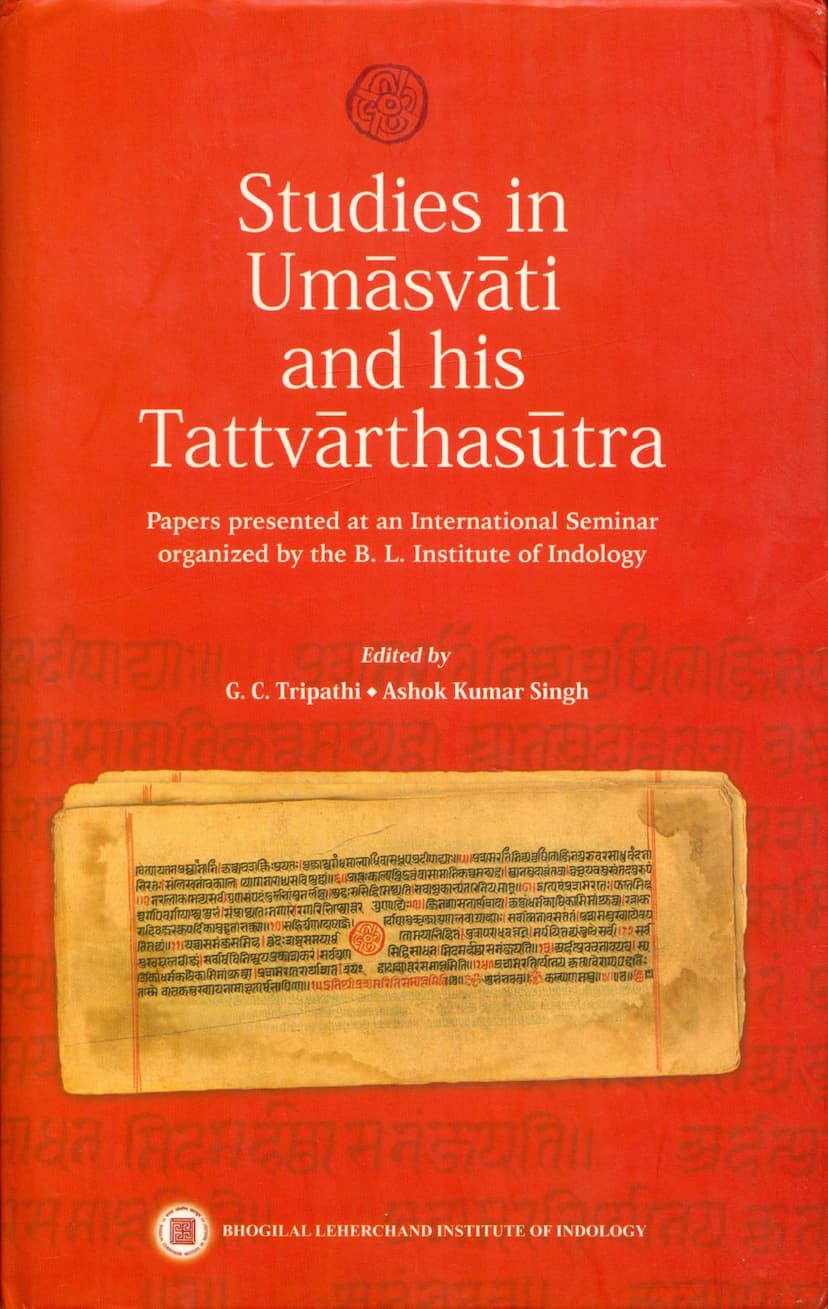Studies In Umasvati And His Tattvartha Sutra
Added to library: September 2, 2025

Summary
This book, "Studies in Umāsvāti and His Tattvārtha Sūtra," is a collection of papers presented at an international seminar organized by the Bhogilal Leherchand Institute of Indology. It delves into the life and works of Umāsvāti, an influential Jain philosopher, and his seminal text, the Tattvārtha Sūtra.
Here's a breakdown of the key aspects discussed in the provided pages:
1. Umāsvāti and the Tattvārtha Sūtra:
- Significance: Umāsvāti is described as one of the earliest and most illustrious authors of Jain philosophical views. His Tattvārtha Sūtra is considered the "bedrock of Jain philosophy," holding a prestige comparable to the Bhagavad Gītā for Hindus or the Bible for Christians.
- Unifying Text: The Tattvārtha Sūtra is unique in being highly revered by both the Śvetāmbara and Digambara sects of Jainism.
- Content: The book explores Umāsvāti's contributions to various concepts within Jainism, including his philosophical ideas, ethical precepts, and cosmology.
- Structure: The Tattvārthasūtra is written in the concise "sūtra style," similar to other Indian philosophical traditions. It comprises around 350 Sanskrit sūtras, generally dated to around 400 CE.
- Authorship Debate: While the book acknowledges controversies surrounding Umāsvāti's authorship and sectarial affiliation, the research presented generally supports his authorship of key works.
2. Umāsvāti's Works:
- Extant Works: The paper by M. A. Dhaky highlights the Sabhāsya-Tattvārthādhigama Sūtra, Praśamaratiprakaraṇa, and Kșetrasamāsa (also known as Jambūdvīpasamāsa) as among his notable works.
- Lost Works: The paper also discusses evidence for at least four other lost compositions attributed to Umāsvāti, including the Śaucaprakaraṇa, Śrāvakaprajñapti, Dānaprakaraṇa, and Dharma-prakaraṇa, identified through quotations in later commentaries.
- Stylistic Peculiarities: Dhaky emphasizes Umāsvāti's distinct writing style, linguistic habits, and compositional modulation as evidence for his authorship across these works.
3. Key Philosophical Concepts Discussed:
- Yoga: N. M. Kansara's paper examines Umāsvāti's concept of "yoga," defined as the activity of body, speech, and mind, and its role as a cause of karmic bondage (āsrava). The paper traces the development of this concept through commentaries by Pūjyapāda, Akalankadeva, Vidyānandi, and Pt. Sukhlalji.
- Sukha (Happiness): Padmanabh S. Jaini's paper explores Umāsvāti's understanding of "sukha," particularly in the liberated state (moksha). He discusses the term "avyābādha" used by Umāsvāti to describe this ultimate happiness, contrasting it with worldly happiness and the differing views between Śvetāmbaras and Digambaras on the nature of the liberated soul.
- Karmic Bondage and Kaṣāyas: Kristi L. Wiley's paper re-examines the role of "kaṣāyas" (passions) in Umāsvāti's theory of karmic bondage, discussing the potential innovation of incorporating kaṣāyas into the process and the early Jain texts' emphasis on "yoga" (activity) alone.
- Existence (Sat): Samani Mangal Prajna's paper analyzes Umāsvāti's contribution to the concept of "existence," particularly his definition of existence as possessing origination, cessation, and persistence, and his classification of existence into four categories (dravyāstika, mātṛkāpadāstika, utpannāstika, and paryāyāstika).
- Parallelism with Yogasūtra: Kusum Patoria's paper highlights similarities between the Tattvārthasūtra and Patañjali's Yogasūtra concerning concepts like variable constancy (pariņāmi-nityatā), dualism, the relation of mind and matter, the concept of Iśvara, and ethical practices like Yama and Mahāvrata.
- The Jaina Universe (Loka): Suzuko Ohira's paper investigates the Jaina concept of the universe (loka) as being shaped like a "Cosmic Man," exploring the origins and implications of this imagery, and Umāsvāti's awareness of it.
- Epistemological Concepts: G. L. Suthar's paper focuses on the epistemological concepts in Umāsvāti's Tattvārthasūtra, as interpreted by the later logician Yaśovijaya. It examines Umāsvāti's views on pramāṇa, naya, and the classification of knowledge.
- Anuyogadvāras: Dayanand Bhargava's paper offers observations on the "anuyogadvāras" (methods of investigation) mentioned in the Tattvārthasūtra, comparing them with lists found in other Jain texts and their application in philosophical discussions.
- Meditation: Jagat Ram Bhattacharyya's paper explores the sources of meditation in the Tattvārthasūtra, drawing parallels with Jaina canons and Hindu Yogaśāstra, and discussing Umāsvāti's classification of meditation.
- Omniscience: Fujinaga Sin's paper analyzes Umāsvāti's discussion of omniscience, distinguishing between its epistemological and karmic aspects, and examining his use of terms like "kevalajñāna."
- Commentaries from Karnataka: Kamala Hampana's paper surveys the Tattvārthasūtra commentaries originating from Karnataka, focusing on early Kannada commentaries like Cūdāmaņi and Sarvārthasiddhi, and the scholarly debates surrounding their authorship and dating.
- Umāsvāti in Kannada Literature: Hampa Nagarajaiah's paper traces the references to Umāsvāti, particularly his epithet "Griddhrapicchācārya," within Kannada literary and epigraphical sources, highlighting the high regard accorded to him.
- Prakarana Literature: Dharmachand Jain's paper provides a study of Umāsvāti's Praśamaratiprakaraṇa, discussing its purpose, structure, key themes like "kalpya" and "akalpya," the process of liberation, the eight types of passions (mad), religious discourse (dharmakatha), and its relationship with the Tattvārthasūtra.
- Tattvārthasūtra Commentarial Literature: Phoolchand Jain Premi's paper provides an overview of the extensive commentarial literature on the Tattvārthasūtra, discussing significant works like Sarvārthasiddhi, Tattvārthavārtika, and Tattvārthādhigama Bhāṣya.
- Soul Concepts: Lata Bothra's paper examines the concept of the soul (ātman) in the Tattvārthasūtra, discussing its definition, dual nature, classification, and the path to liberation as described by Umāsvāti.
- ** निर्जरा (Karma Dissipation):** Samani Kusum Pragya's paper reviews the concept of "nirjarā" (karma dissipation) in the Tattvārthasūtra, particularly the stages of spiritual progress that lead to varying degrees of nirjarā, and compares these stages with those described in other Jain texts.
- Quotations in Sarvārthasiddhi: Kamlesh Kumar Jain's paper analyzes the quotations found in Pūjyapāda Devanandi's Sarvārthasiddhi, categorizing them by their sources (Vedic, Shad-darśana, Buddhist, Jain āgamic, and grammatical literature) and discussing the implications of these citations for understanding the intellectual milieu of that period.
In essence, this collection of essays aims to provide a comprehensive exploration of Umāsvāti's profound impact on Jain philosophy and literature, with a particular focus on his magnum opus, the Tattvārthasūtra, through the lens of academic research and commentary.